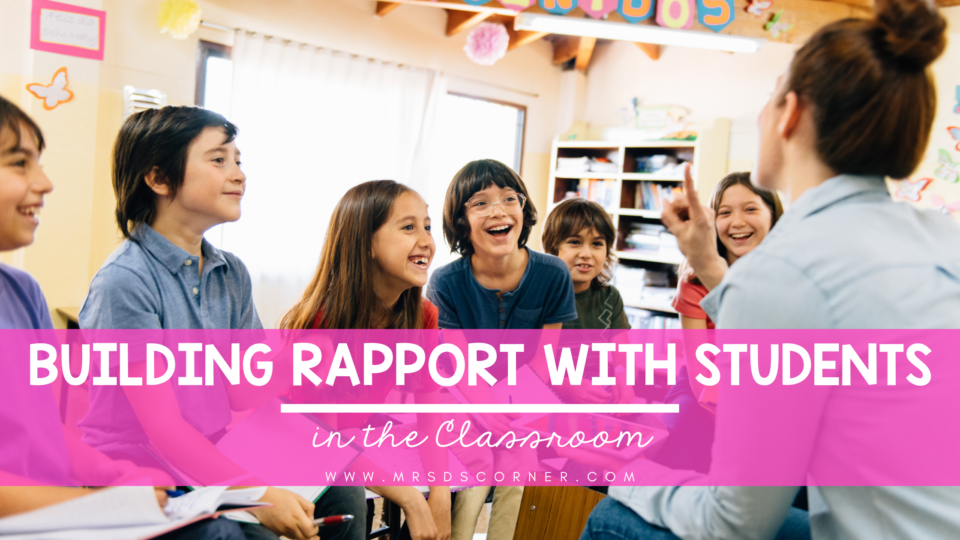Building rapport with students is a crucial aspect of effective teaching. When students feel connected to their teachers, they are more engaged, motivated, and eager to learn. The saying that students don’t care about what you’re teaching until they know that you care about them has never been more true.


Establishing a positive relationship with students can lead to a more conducive learning environment and better academic outcomes both in the general ed classroom and in special education settings. But how do you build rapport?
Here are some tips and best practices for educators to develop rapport with their students.
Show Genuine Interest
One of the key ways to build rapport with students is by showing a genuine interest in their well-being and success. Take the time to get to know your students on a personal level. Ask them about their interests, hobbies, and aspirations. Show empathy and understanding towards their challenges and achievements.
Students know when someone is not being truthful or genuine with them, so don’t try to fake your interest in them. Be genuinely curious about who your students are as individuals. Chances are that they’ll be open to telling you more about who they are when they know that you care.
Practical Example: If a student mentions that they enjoy playing basketball, you can ask them about their favorite team or player. This simple gesture shows that you are interested in their life outside the classroom.
Communicate Effectively
Effective communication is essential in building rapport with students. Listen actively to their concerns, feedback, and ideas. Be approachable and open to dialogue. Provide clear instructions and explanations to ensure that students understand the material.
One of the worst things you can do is to dismiss your students’ concerns or ideas. It shows them that you’re not really invested in them and have your own agenda. While that agenda may be to teach them, that won’t happen if you don’t care about them first.
Practical Example: Encourage students to ask questions during class discussions. Acknowledge their contributions and validate their thoughts and opinions. Actively listen and hear what they’re saying.
Be Supportive and Encouraging
Create a supportive and inclusive classroom environment where students feel safe to express themselves and take academic risks. Offer praise and encouragement to boost their confidence and self-esteem. Provide constructive feedback that highlights their strengths and areas for improvement.
That doesn’t mean that you shouldn’t challenge them academically, it just means that you should acknowledge the hard work that they are putting in already. When students understand that you want them to do better and are challenging them for their own good and growth, they are more likely to work harder and achieve more.
Practical Example: If a student struggles with a particular concept, offer additional resources or one-on-one support to help them overcome those challenges. Don’t point out their shortcomings or struggles in front of the whole class. Address them privately.
Respect Diversity
Acknowledge and respect the diversity of your students, including their cultural backgrounds, learning styles, and abilities. Celebrate individual differences and promote a sense of belonging for all students in the classroom.
None of your students are exactly the same and that’s what makes them all so special. Respect the diversity and what that brings to the classroom.
Practical Example: Incorporate diverse perspectives and cultural references into your teaching materials to create a more inclusive learning experience for all students.
Build Trust
Trust is the foundation of any meaningful relationship, including the one between teachers and students. Be honest, reliable, and consistent in your interactions with students. Honor your commitments and demonstrate integrity in your actions.
If you say you’re going to do something, do it. If you say there’s a specific consequence for something, stand by that consequence. Be a teacher of your word.
Practical Example: Keep promises made to students, such as providing timely feedback on assignments or following up on academic concerns raised during parent-teacher meetings. Your students and their families need to know that they can trust you.
By implementing these strategies and best practices, teachers can cultivate a strong rapport with their students, leading to a more engaging and supportive classroom learning environment. Remember that building rapport takes time and effort but is ultimately rewarding for both teachers and students alike. Start from the very first day of school and stay consistent throughout the year. The rapport you build with your students will be something that helps carry them throughout the entirety of their school career and will be the reason they come back to visit you and remember you so fondly.

